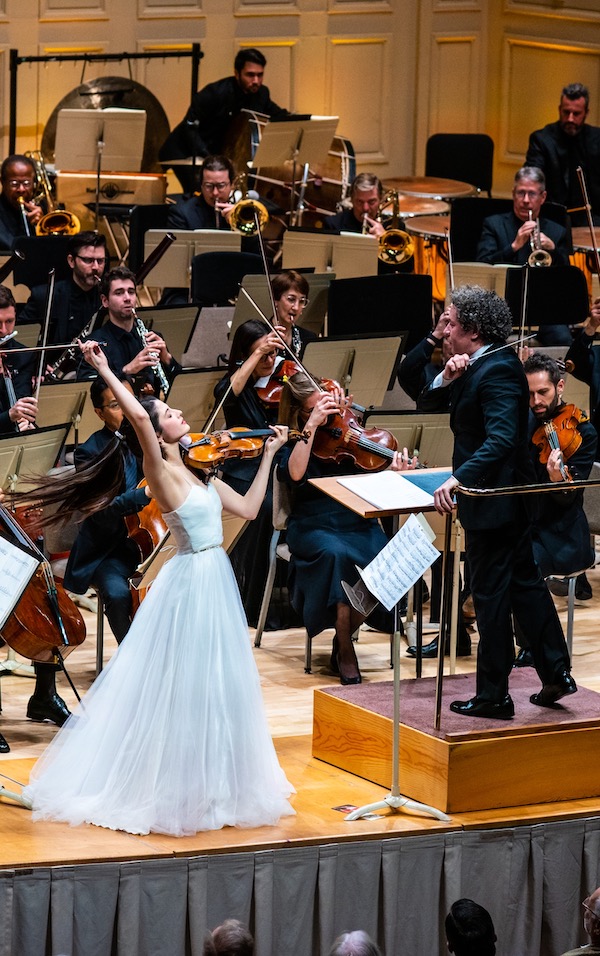Young violinist shines brightest amid the glitz and fury of Dudamel, LA Philharmonic

Violinist Maria Dueñas performed Gabriela Ortiz’s Altar de cuerda with Gustavo Dudamel and the Los Angeles Philharmonic Sunday at Symphony Hall. Photo: Robert Torres
Such was the intensity of the cheering that greeted Gustavo Dudamel and the Los Angeles Philharmonic Orchestra Sunday afternoon at Symphony Hall that one could be forgiven for thinking the ensemble had been absent in Boston for decades. Then again, November 2019 feels like a lifetime ago.
Not that the Philharmonic or their charismatic music director have lost a step in the interim. Rather, both seem to be going from strength to strength. This weekend’s performance, presented by the Celebrity Series, offered two works that powerfully advanced the case that this orchestra is, if not the country’s best, then among the top two.
The first was Gabriela Ortiz’s Altar de cuerda (String Altar). Written for the Spanish prodigy Maria Dueñas, this three-movement violin concerto is a thrilling, colorful entry into the genre.
The opening movement, “Morisco chilango” (“Chilango Moorish” – the former term is nickname for Mexico City natives) alternates free, cadenza-like violin figures with angular dancing episodes that often brilliantly involve the orchestra. Meanwhile, the central “Canto abierto” (“Open song”) features soulful violin lines emerging from and soaring above murky symphonic textures. The concluding “Maya déco” (“Mayan deco”) is again extroverted, overflowing with wild figurations that are passed between soloist and ensemble.
On Sunday, the 19-year-old Dueñas impressed mightily. The winner of last year’s Menuhin Competition, her playing commands attention. It can be passionate and full-bodied: the opening solo statements in the first movement called to mind the mature tone and intense vibrato of Anne-Sophie Mutter.
Yet she’s also capable of an airy dexterity that was skillfully employed in the outer movements’ fleet sections, as well as during the concerto’s several cadenzas (and in her encore of Ruggiero Ricci’s arrangement of Tarrega’s Recuerdos de la Alhambra). In the central “Canto,” Dueñas’ playing of the long-breathed melodic lines – silken and pure-toned – set up a potent contrast with that movement’s fiery cadenza. Suffice it to say, this is an artist with a bright future ahead of her.
Throughout the thirty-minute-piece, Ortiz’s writing demonstrates an extraordinary ear for sonority coupled with a keen sense of rhythm, melody, and structure. Taken together, those are traits one doesn’t often encounter in such pristine balance among living composers.
Dudamel and the Philharmonic seemed to intuit as much, delivering an account of Altar’s orchestral writing that was rhythmically taut and lucidly balanced, as well as mightily assured: one expects such stylistic confidence in Beethoven, not a brand-new piece. Regardless, the first movement’s folkish orchestral refrains—especially the brass and timpani riffs—were raucous, while the second’s ominous gestures rumbled with a breathtaking sense of direction. The finale, which at times suggested a south-of-the-border hoedown crossed with Bartók’s Concerto for Orchestra, simply dazzled.
That latter adjective applied equally well to the Philharmonic’s account of Mahler’s First Symphony. If Sunday’s interpretation had its quirks, the performance—with its flawless balances, blazing colors, sensitive nuances of dynamics, motivic coherence, and melodic naturalness—came about as close to perfection as is possible in Mahler.
Throughout, Dudamel’s approach reminded that this score is the product of youth: Mahler was just 29 when he conducted the premiere of the symphony’s first version in Budapest in 1889. Tempos were flexible but moved inexorably forward. The recurring triplet motive first heard in the opening movement’s introduction was always pert and plucky. The finale’s outer sections drove headlong.
At the same time, certain of the conductor’s choices—like deliberately holding back each rough-hewn iteration of the Ländler’s main theme and pushing the finale’s coda hard before suddenly pulling back on the reins —felt mannered. Surely, it’s better to let the music play itself rather than intervene so heavy-handedly.
Still, Dudamel’s overall take on the piece was compelling. Seating the violin sections across from one another on the stage helped underline the score’s spatial aspect. The finesse of the Philharmonic’s ensemble—in many regards, this was a chamber performance from 100 musicians—resulted in all sorts of motivic connections emerging within and across movements, as well as glorious individual moments: the string dovetailing at the end of the second movement’s Trio, for one, was miraculously smooth.
Above all, the symphony’s songful character (the score quotes two of Mahler’s Songs of a Wayfarer) came through as strongly as did the reading’s emphasis on dramatic tension and release. This was particularly true in the third movement, with its notably warm double bass solo from principal Christopher Hanulik and its tender citation of “Die zwei, blaue Augen.”
Afterwards, Dudamel led his orchestra in Paul Desenne’s riotous arrangement of Johann Strauss, Jr.’s Tritsch-Tratsch Polka, “Triqui Traqui.” Rarely does an encore so perfectly and whimsically sum up a concert. Yet this one, with its mix of alt-Wien and contemporary Latin musical gestures suggested something much more substantial: the astonishing vigor an institution can take on when it embraces the present as fervently as it does the past. In this, the L.A. Phil is second to none.
The Celebrity Series presents Anne-Sophie von Otter and Kristian Bezuidenhout performing music by Schubert, Mozart, and Adolf Fredrik Lindblad 8 p.m. November 5 at Jordan Hall. celebrityseries.org
Posted in Performances